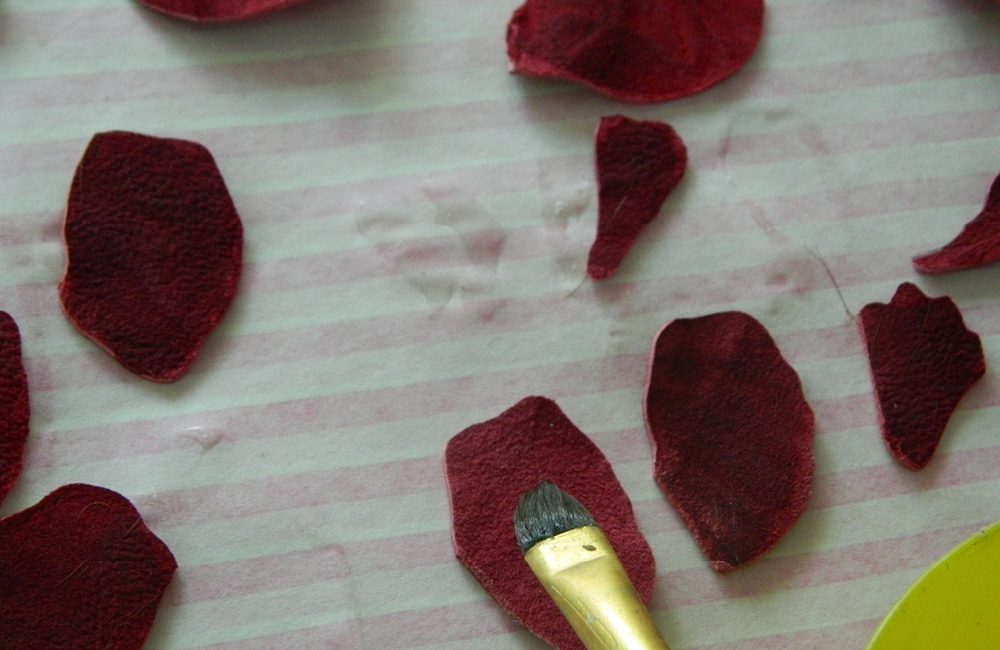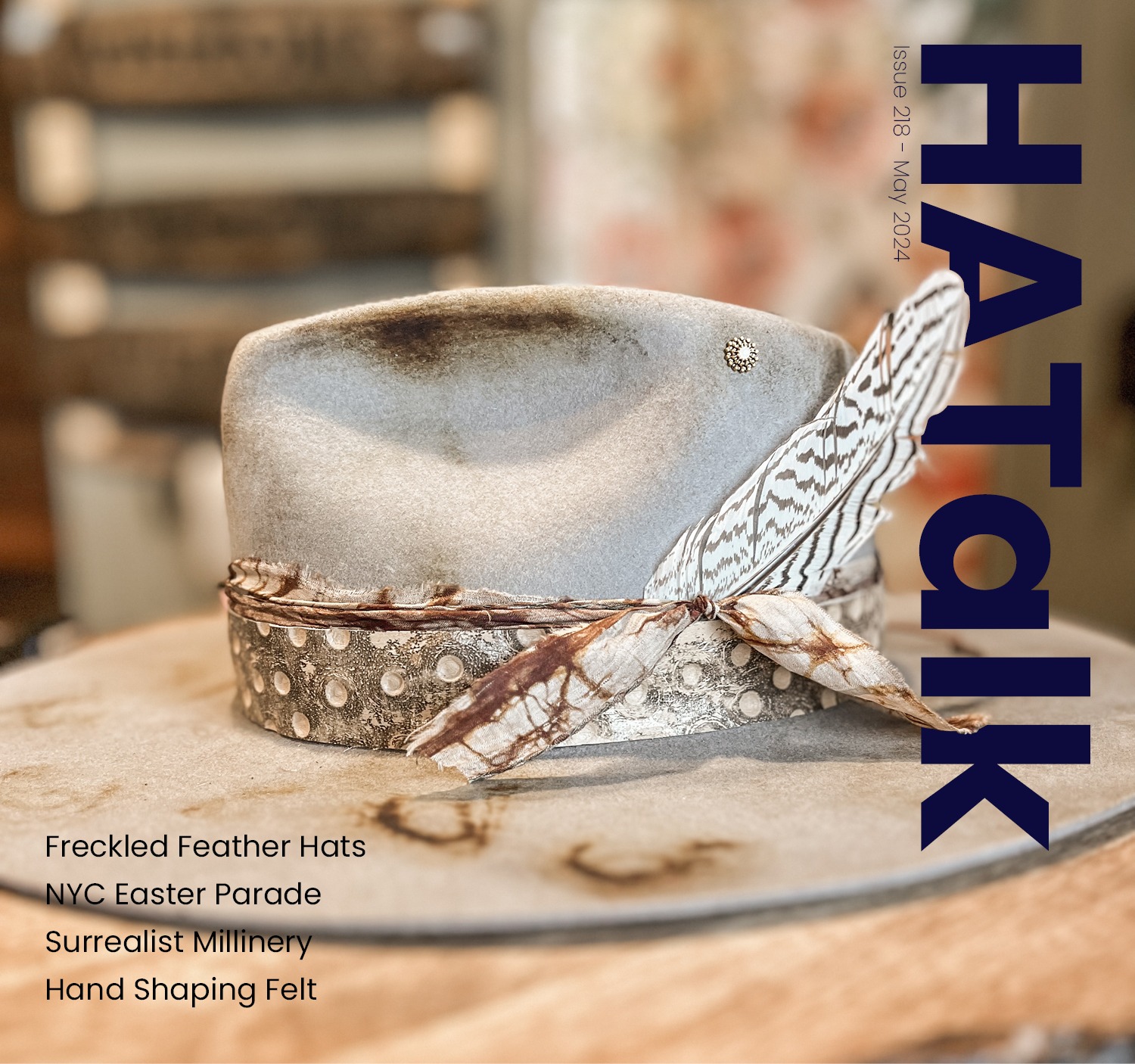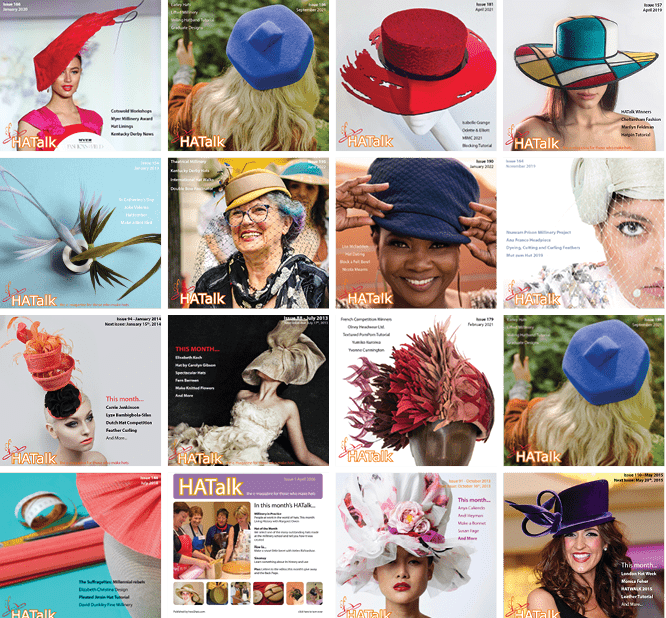Blog / A Look at Millinery Stiffeners

A Look at Millinery Stiffeners
What are Millinery Stiffeners?
There are many different millinery stiffeners to choose from when creating your hat designs. Just be careful, some of them can be hazardous to your health!
Historically, chemicals like mercurous nitrate were used to stiffen felt and prolonged exposure led to mercury poisoning (thus the phrase, “Mad as a hatter”). These days, you can find plenty of stiffeners that are not hazardous and are water soluble. And you may have some of them in your home already!
Water-Based Millinery Stiffeners
The most basic and popular stiffeners are water-based. One of the most common is gelatin. Dissolved in hot water, it is biodegradable and user-friendly. Gum Arabic and corn starch are also homemade stiffeners that have useful applications, especially with flower making. Plus, the spray starch from your laundry room can be used to help hold rolled sinamay edges and hairspray can keep feathers in place!
The solution most often used with sinamay is a water-based solution, comprised of a PVA base (e.g. white Elmer’s school glue). It is non-toxic and non-flammable. Polyvinyl Alcohol is sometimes referred to as PVA as well, but this comes in a powder form and has to be mixed with water. All these water-based solutions can be stored for short periods in a sealed container once mixed.
Solvent-Based Millinery Stiffeners
Some solvent and chemical stiffeners are still available and are generally used for felts, straws or other thicker materials. Because they are hazardous materials, however, they cannot always be shipped. It is best to check this with the supplier before ordering. Some glues and stiffeners are not allowed on airplanes at all, so be careful if you are shopping overseas, too. If you do use a chemical based stiffener, always refer to the manufacturer’s safety information and use in a very well-ventilated area. You do not want to breathe the fumes in!
Applying Stiffeners
Stiffeners can be sprayed on, applied with a brush (as shown in the Leather Camellia Project above), or used as a solution to dip materials into. They may come in a concentrated form and need to be diluted with water for use. The ratio you use to dilute your stiffener will depend on the stiffener and material you are working with. Some stiffeners leave a light sheen once dried, which may or may not be the effect you’re looking for. All stiffeners should be tested on a small patch of the material you are working with before you begin.
Learning to work with millinery stiffeners is a process of experimentation. There is no “right” ratio; the material you are using and your personal preferences will influence which type of stiffeners you use and how much you dilute them. It is best to keep a small selection on hand to try out; different fabrics will react differently to various stiffeners. What you are making will influence your decisions as well – flower making will require different concentrations and types of stiffeners than a thick straw hat, so play around and see what works best with your hat styles and millinery designs.

About the Author
Amy Fowler is the creator of the bespoke, California-based Millinery by Amy Fowler label. She also runs Humboldt Haberdashery, an online millinery supplier.
See Amy’s full bio HERE.
Popular Articles
Latest e-Magazine
Featured Supplier

A Look at Millinery Stiffeners
What are Millinery Stiffeners?
There are many different millinery stiffeners to choose from when creating your hat designs. Just be careful, some of them can be hazardous to your health!
Historically, chemicals like mercurous nitrate were used to stiffen felt and prolonged exposure led to mercury poisoning (thus the phrase, “Mad as a hatter”). These days, you can find plenty of stiffeners that are not hazardous and are water soluble. And you may have some of them in your home already!
Water-Based Millinery Stiffeners
The most basic and popular stiffeners are water-based. One of the most common is gelatin. Dissolved in hot water, it is biodegradable and user-friendly. Gum Arabic and corn starch are also homemade stiffeners that have useful applications, especially with flower making. Plus, the spray starch from your laundry room can be used to help hold rolled sinamay edges and hairspray can keep feathers in place!
The solution most often used with sinamay is a water-based solution, comprised of a PVA base (e.g. white Elmer’s school glue). It is non-toxic and non-flammable. Polyvinyl Alcohol is sometimes referred to as PVA as well, but this comes in a powder form and has to be mixed with water. All these water-based solutions can be stored for short periods in a sealed container once mixed.
Solvent-Based Millinery Stiffeners
Some solvent and chemical stiffeners are still available and are generally used for felts, straws or other thicker materials. Because they are hazardous materials, however, they cannot always be shipped. It is best to check this with the supplier before ordering. Some glues and stiffeners are not allowed on airplanes at all, so be careful if you are shopping overseas, too. If you do use a chemical based stiffener, always refer to the manufacturer’s safety information and use in a very well-ventilated area. You do not want to breathe the fumes in!
Applying Stiffeners
Stiffeners can be sprayed on, applied with a brush (as shown in the Leather Camellia Project above), or used as a solution to dip materials into. They may come in a concentrated form and need to be diluted with water for use. The ratio you use to dilute your stiffener will depend on the stiffener and material you are working with. Some stiffeners leave a light sheen once dried, which may or may not be the effect you’re looking for. All stiffeners should be tested on a small patch of the material you are working with before you begin.
Learning to work with millinery stiffeners is a process of experimentation. There is no “right” ratio; the material you are using and your personal preferences will influence which type of stiffeners you use and how much you dilute them. It is best to keep a small selection on hand to try out; different fabrics will react differently to various stiffeners. What you are making will influence your decisions as well – flower making will require different concentrations and types of stiffeners than a thick straw hat, so play around and see what works best with your hat styles and millinery designs.

About the Author
Amy Fowler is the creator of the bespoke, California-based Millinery by Amy Fowler label. She also runs Humboldt Haberdashery, an online millinery supplier.
See Amy’s full bio HERE.







